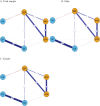Interconnected mental health symptoms: network analysis of depression, anxiety, stress, and burnout among psychiatric nurses in the context of the COVID-19 pandemic
- PMID: 39529901
- PMCID: PMC11550990
- DOI: 10.3389/fpsyt.2024.1485726
Interconnected mental health symptoms: network analysis of depression, anxiety, stress, and burnout among psychiatric nurses in the context of the COVID-19 pandemic
Abstract
Background: Mental health symptoms such as anxiety, depression, stress, and burnout are common among healthcare workers. However, the interconnections among them remain under-explored. This study aimed to address the interrelationships among these symptoms in psychiatric nurses.
Methods: We conducted a nationwide survey in the early stage of the COVID-19 pandemic (January to March 2021) to investigate the interconnectedness of depression, anxiety, stress, and burnout among psychiatric nurses. Using network analysis, we identified central symptoms, important bridge symptoms, and the correlations among these central symptoms.
Results: Of the 9,224 psychiatric nurses (79.2% female) included in the statistical analyses, 27.6% reported clinically significant depression, 31.2% anxiety, 14.5% stress, and 23.8% burnout. Network analysis revealed that stress had the highest expected influence (EI) value (0.920) and the highest strength among all nodes. The node for depression scored the highest in both closeness and betweenness. Emotional exhaustion (EE) had the highest bridge expected influence (BEI) of 0.340, with the strongest intergroup association between EE and depression. No significant differences were found in gender or frontline work experience (all p > 0.05).
Conclusions: Burnout, depression, anxiety, and stress are relatively common among psychiatric nurses in the context of the COVID-19 pandemic. While anxiety was the most prevalent, stress emerged as the core symptom, and depression as an important bridging node. Interventions targeting the core symptoms and bridging nodes may improve the mental health of psychiatric nurses.
Keywords: anxiety; burnout; depression; network analysis; psychiatric nurses; stress.
Copyright © 2024 Tao, Wang, Lu, Liu, Xia, Mo, Geng, Liu, Liu, Jiang, Liu and Tang.
Conflict of interest statement
The authors declare that the research was conducted in the absence of any commercial or financial relationships that could be construed as a potential conflict of interest.
Figures



Similar articles
-
Unraveling the interconnectedness between physician burnout and symptoms of depression, anxiety, and stress: a network analysis among Chinese psychiatrists.Front Public Health. 2025 Jan 7;12:1493424. doi: 10.3389/fpubh.2024.1493424. eCollection 2024. Front Public Health. 2025. PMID: 39839405 Free PMC article.
-
The interplay among burnout, and symptoms of depression, anxiety, and stress in Chinese clinical therapists.Sci Rep. 2024 Oct 26;14(1):25461. doi: 10.1038/s41598-024-75550-7. Sci Rep. 2024. PMID: 39462028 Free PMC article.
-
Gender differences in the experience of burnout and its correlates among Chinese psychiatric nurses during the COVID-19 pandemic: A large-sample nationwide survey.Int J Ment Health Nurs. 2022 Dec;31(6):1480-1491. doi: 10.1111/inm.13052. Epub 2022 Aug 11. Int J Ment Health Nurs. 2022. PMID: 35957615 Free PMC article.
-
Moral injury and mental health among health-care workers during the COVID-19 pandemic: meta-analysis.Eur J Psychotraumatol. 2023;15(1):2299659. doi: 10.1080/20008066.2023.2299659. Epub 2024 Jan 8. Eur J Psychotraumatol. 2023. PMID: 38189775 Free PMC article. Review.
-
Burnout status of healthcare workers in the world during the peak period of the COVID-19 pandemic.Front Psychol. 2022 Sep 21;13:952783. doi: 10.3389/fpsyg.2022.952783. eCollection 2022. Front Psychol. 2022. PMID: 36211838 Free PMC article.
Cited by
-
Psychological Distress Among Chinese Manufacturing Employees: Prevalence and a Symptom Network Analysis.Psych J. 2025 Aug;14(4):603-613. doi: 10.1002/pchj.70015. Epub 2025 Apr 29. Psych J. 2025. PMID: 40300878 Free PMC article.
-
Stress, Anxiety and Depressive Symptoms, Burnout and Insomnia Among Greek Nurses One Year After the End of the Pandemic: A Moderated Chain Mediation Model.J Clin Med. 2025 Feb 10;14(4):1145. doi: 10.3390/jcm14041145. J Clin Med. 2025. PMID: 40004676 Free PMC article.
References
-
- GBD 2021 Demographics Collaborators . Global age-sex-specific mortality, life expectancy, and population estimates in 204 countries and territories and 811 subnational locations, 1950-2021, and the impact of the COVID-19 pandemic: a comprehensive demographic analysis for the Global Burden of Disease Study 2021. Lancet. (2024) 403:1989–2056. doi: 10.1016/S0140-6736(24)00476-8 - DOI - PMC - PubMed
LinkOut - more resources
Full Text Sources

